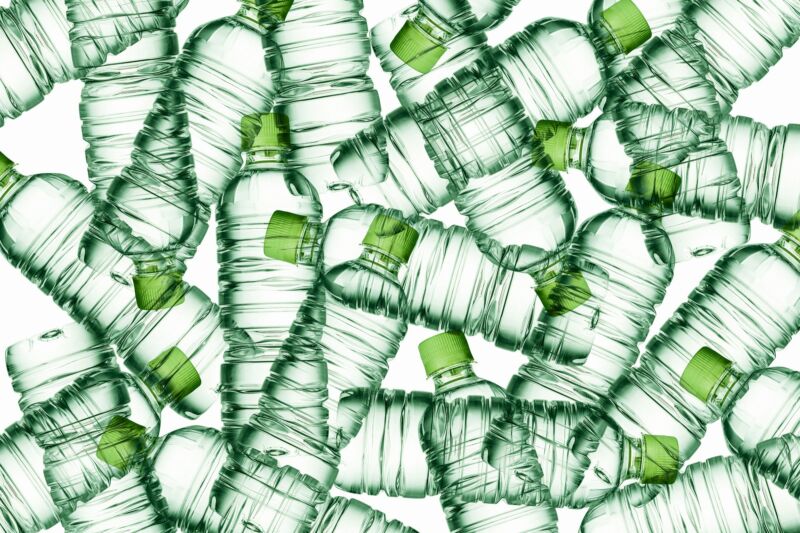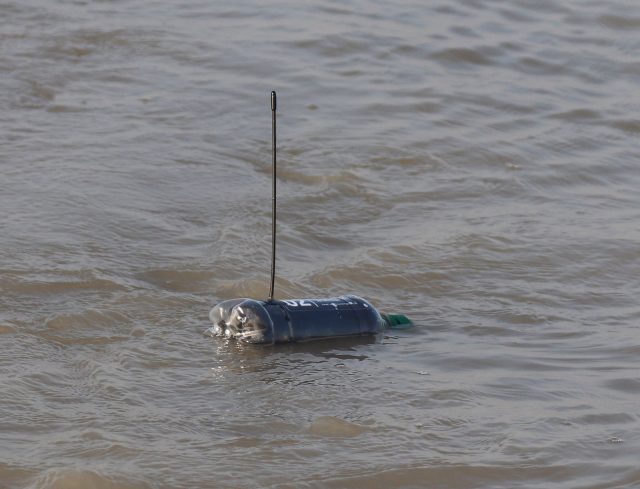I’ll send an SOS to the world — Researchers loaded containers with trackers and let them float away.

Someone living along the Ganges River in India recently received a gift that we can safely say no one on Earth had ever gotten before. At first, it must have looked like an ordinary plastic bottle floating down the river, save for the rod poking out of its top, like a sailboat with a mast but no sail. The giftee, who remains anonymous, must have gotten curious and ripped open the 500-milliliter bottle, finding that it was in fact packed with electronics. Those included a SIM card, which the person popped into a mobile device and then logged into Facebook.
“The reason we knew it was in use was when we got the bill,” says Alasdair Davies, a technical specialist at the Zoological Society of London. You see, Davies, along with conservation scientist Emily Duncan of the University of Exeter and other researchers, had not long before released the bottle and nine others into the Ganges as part of a clever experiment to show how plastic pollution moves through rivers and eventually out to sea. SIM cards allowed the ill-fated bottle and its companions to connect to cell towers every three hours as they journeyed down the river, recording in great detail how far and how fast the devices traveled. One sailed 380 miles over 51 days.

But this particular bottle had gone rogue. The researchers had planned on the SIM card using no more than 100 megabytes of data, given that each upload to a cell tower took a mere 2 kilobytes, max. This card had managed to rack up 300 megabytes of data. “We were like, ‘How the hell has our bottle used 300 megs’ worth of data?’” Davies recalls. So they looked at the location logs, and watched the bottle jump out of the river and land in someone’s house—not typical behavior for an inanimate object. “Then it went offline, and then the data started accumulating,” he says.
While some of the bottles traveled many miles over many weeks, others lost their ability to transmit their location. Still others seem to have got caught up in fishing nets. But that’s not a waste of an electronic research bottle—quite the opposite, in fact. “It kind of gives realistic data of what does happen to plastic,” says Duncan, lead author on a new paper in PLOS ONE describing the system. “Some might be taken out of the river, and some might get caught in fishing gear out there. So our misadventures also give us a realistic idea of what happens.”
Duncan and Davies actually cobbled together two generations of electronic bottles. Their first generation of devices, the ones that sailed along the Ganges, had plenty of cell towers to ping along the way, so a SIM card would do. But the researchers also wanted to see how plastic bottles might behave once they get to the ocean. So they outfitted a second generation with GPS. Here they took inspiration from their prior work tracking sea turtles: GPS works great on the open ocean, far away from any cell service. (Their designs are open source, so any plastic researcher can build their own and even improve upon the system.)
“The right everything”
For both versions of the device, they had to figure out how to make an electronics-stuffed tube behave like a real piece of plastic trash. “It’s all about the center of gravity, really,” says Davies. They couldn’t, for instance, load all the batteries onto one side of the bottle. They also left an open cavity within the bottle, so the trapped air would give it buoyancy, keeping about half the device above the waterline and half below. Critically, the bottle had to orient itself such that its antenna pointed skyward, not toward the river bottom.
“We played a lot in buckets in our back gardens, floating the bottles, testing configurations, getting it just right,” Davies says. “The right thickness of wall—the right everything—until we got something that would mimic a bottle. So we threw another bottle in beside it, and they would float in the same orientation.”
Confident of the seaworthiness of the GPS versions of the bottles, the team deployed them in Bangladesh, near the mouth of the Ganges, and also in the Bay of Bengal. The researchers then watched how the devices scooted around the Bay of Bengal along similar trajectories. One bottle traveled nearly 1,800 miles in 94 days. They tended to head westward, toward the east coast of India, eventually getting caught up in strong eddy systems. “On the map, we see kind of spiraling starting to happen,” Duncan says. “That’s the indication of where we might be finding accumulations of plastic.”

University of Exeter
And that turns out to be the point of carefully engineering plastic bottles to survive grueling journeys down the Ganges and across the Bay of Bengal: It shows where trash tends to gather in these waters. Previously, scientists had developed models—based on variables like ocean currents, winds, and the shapes of coastlines—to show how pieces of plastic might travel around the environment. These models indicate that trash tends to stick around the coast, washing a little ways out, then washing back in, over and over. This new work’s findings lend strong real-world evidence to back up that dynamic: the electronic bottles tended to hug the coastline, traveling hundreds of miles parallel to it instead of immediately washing far out to sea.
“Oceanographic models can highlight and provide valuable insight into how plastics likely move in the ocean,” says Nicholas Mallos, senior director of the Trash Free Seas Program at the Ocean Conservancy, who wasn’t involved in the new research. “But using real-time plastic-tracking tools can help us reveal perhaps previously unknown things.” For instance, where might plastic get caught up in sinks on the open ocean? Might critical habitats be disproportionately threatened by accumulating plastic?
“Where’s the missing plastic?”
“In general, one of the biggest gaps we have had is trying to identify how far plastics move once in the environment,” Mallos adds. “In fact, a lot of researchers will even ask the question: where’s the missing plastic? Because we have quantified how much is likely going into the ocean, but we have not yet been able to fully quantify where is all that plastic ending up, just through the vastness of the ocean.”
The data gathered from these electronic bottles could help inform how humanity tackles the ocean plastic crisis. In 2018, a group called The Ocean Cleanup deployed a 600-meter-long, U-shaped catcher in the Great Pacific Garbage Patch, where plastic waste is known to accumulate. Oceanographers immediately panned the idea, both because the catcher would inevitably break in two (yep, it did), and because it’s a distraction from more preventative solutions. That’d be tackling the pollution way farther upstream, keeping it from reaching the ocean in the first place. To this end, Baltimore Harbor has deployed two “interceptors,” affectionately known as Mr. Trash Wheel and Professor Trash Wheel, that gobble up floating plastic before it can reach the Atlantic Ocean and pile it in barges for disposal. It’s such a good idea that The Ocean Cleanup made their own version for deployment at the mouths of the world’s rivers.
As these new electronic bottles clearly demonstrate, plastic can float hundreds of miles, and maybe more, downstream in rivers. That kind of resilience shows that the pollution is hell-bent on eventually reaching the ocean. Also, you’ve got another problem: there are hundreds of miles of riverbank along which new pieces of trash can enter the system. In other words, it’s not just coastal cities that are loading rivers with plastic bottles that make a journey of maybe a few miles to the sea, but cities up and down the length of the river.
Beyond bottles
Bottles are only part of the problem—a galaxy of other plastic products, like containers and wraps, are making their way into rivers and into the sea. How might they all behave once they hit the water? Duncan and her colleagues may one day adapt their technology to find the answer by putting trackers in even tinier pieces of trash. “Because the tech moves so fast, and everything gets smaller and lighter so easily, it would be really interesting to basically end up with something you can just stick on the crisp packet or a plastic bag,” Duncan says. “Something that’s much more lightweight, that won’t affect how it moves, and to be able to track these pieces as well.”
And because this project is open source, researchers the world over can build their own sensor-packed plastics. So the next time you’re strolling by a river, lamenting the pollution floating by, take heart in the fact that those pieces of trash may in fact be scientific spies.
This story originally appeared on wired.com.

